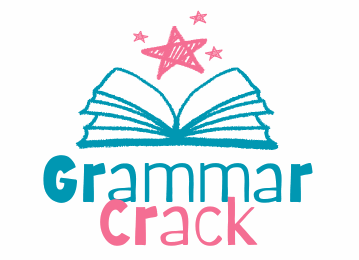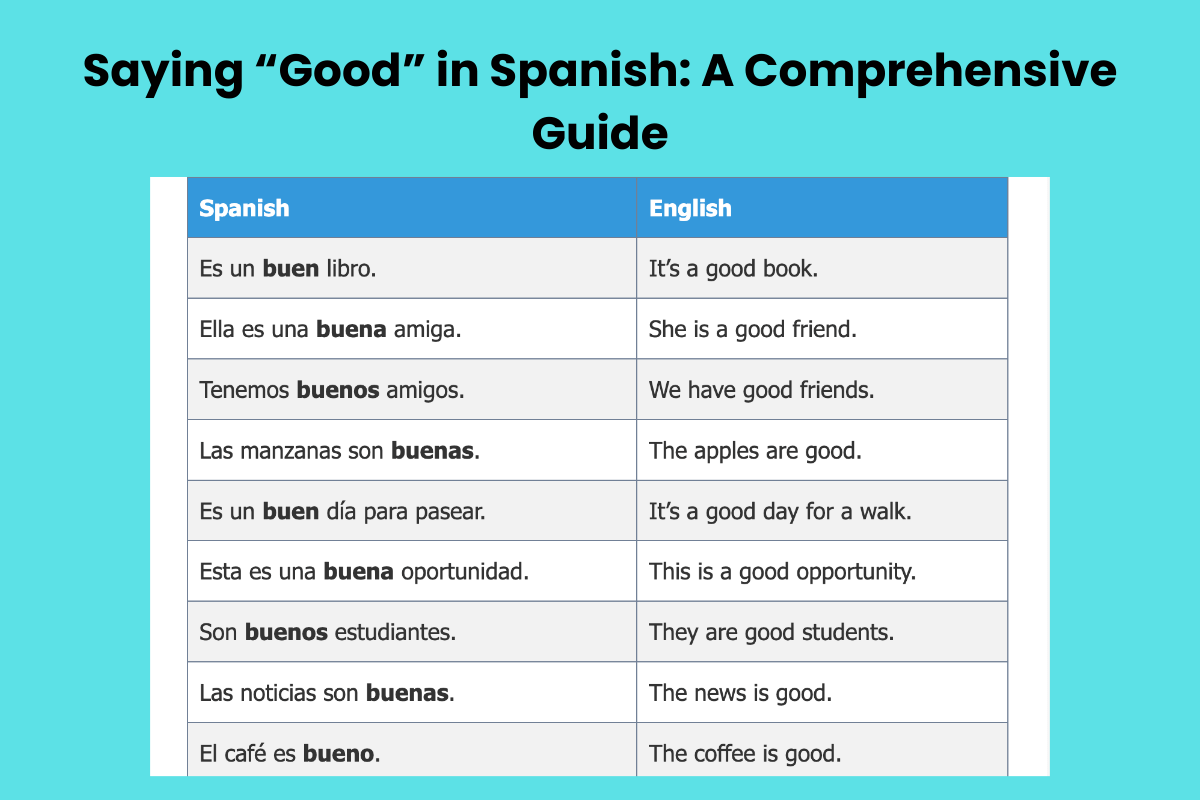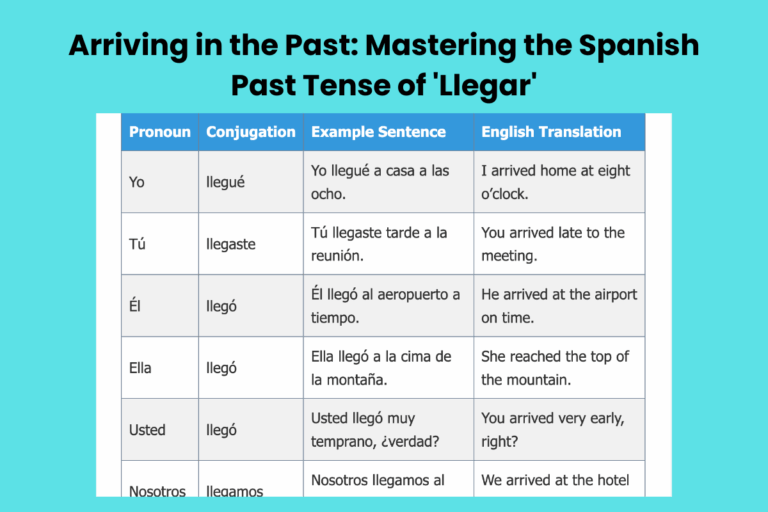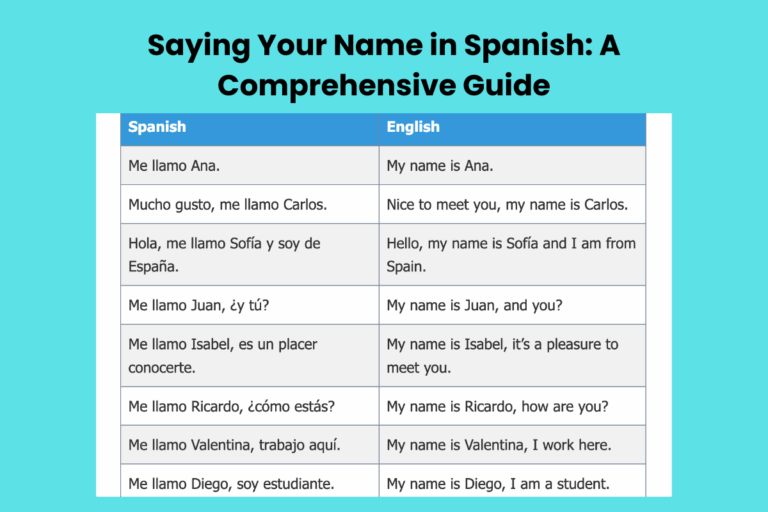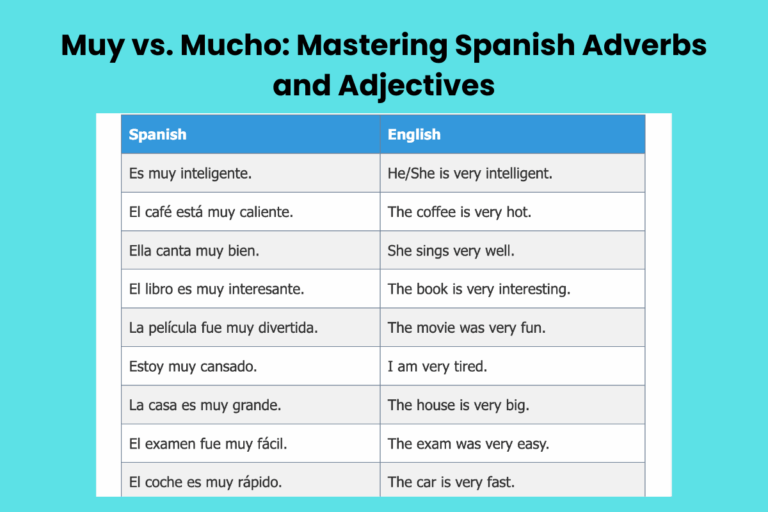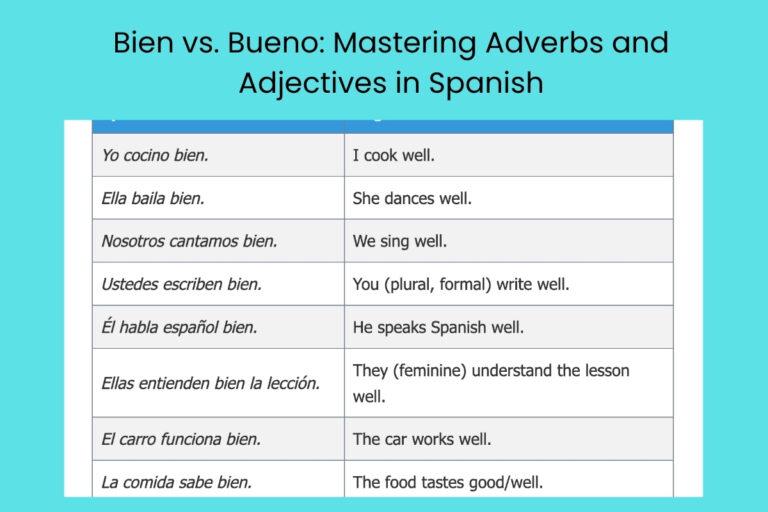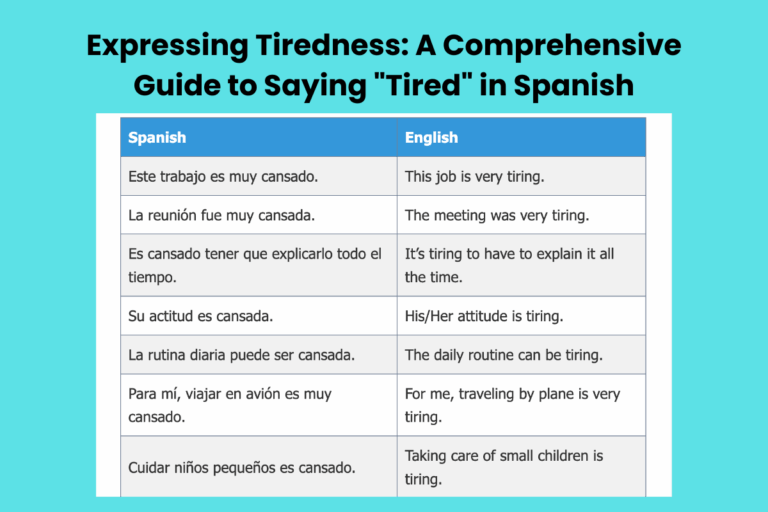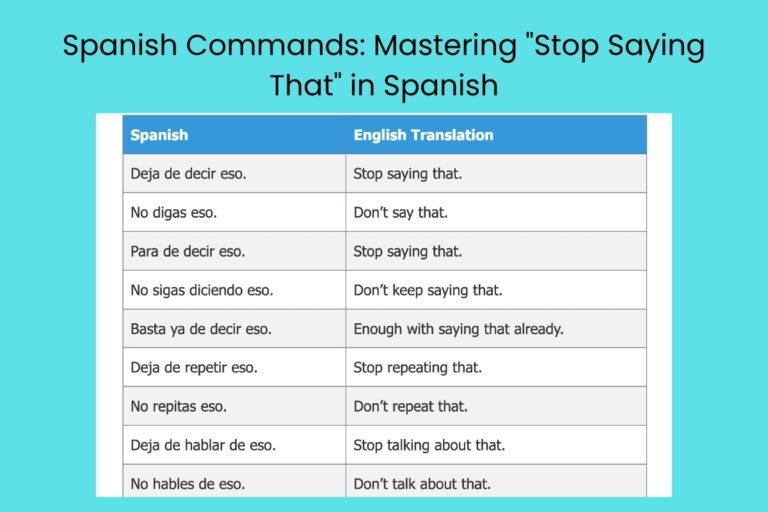Saying “Good” in Spanish: A Comprehensive Guide
Mastering how to say “good” in Spanish is crucial for effective communication and expressing approval, agreement, or satisfaction. The Spanish language offers various ways to convey “good,” each with its specific context and usage.
This comprehensive guide will explore the nuances of translating “good” into Spanish, covering its different forms, grammatical rules, and practical examples. Whether you’re a beginner or an advanced learner, this article will provide you with the knowledge and practice to confidently use “good” in Spanish.
Understanding these nuances is essential for anyone learning Spanish, as using the wrong word can lead to misunderstandings or awkward conversations. By the end of this article, you will be well-equipped to choose the correct translation of “good” based on the context.
Table of Contents
- Introduction
- Definitions of “Good” in Spanish
- Structural Breakdown
- Types and Categories
- Examples
- Usage Rules
- Common Mistakes
- Practice Exercises
- Advanced Topics
- FAQ
- Conclusion
Definitions of “Good” in Spanish
The most common translations of “good” in Spanish are bueno/buena and bien. However, other words like excelente and estupendo can also be used to express varying degrees of goodness or approval. Each word has specific uses and contexts, which we will explore in detail.
Bueno/Buena
Bueno (masculine) and buena (feminine) are adjectives that describe the quality of a noun. They mean “good” in the sense of being of high quality, moral, or beneficial. The form changes based on the gender of the noun it modifies.
Example: Un bueno libro (A good book). Una buena amiga (A good friend).
Bien
Bien is an adverb that describes how something is done or the state of being. It means “well,” “good,” or “right.” It is often used after verbs to indicate that something is done in a good way or that someone is in a good state of health or well-being.
Example: Estoy bien (I am well). Él canta bien (He sings well).
Excelente
Excelente is an adjective that means “excellent.” It’s used to describe something that is of very high quality or outstanding.
Example: Una idea excelente (An excellent idea). Un trabajo excelente (An excellent job).
Estupendo
Estupendo is an adjective that means “wonderful” or “great.” It conveys a sense of enthusiasm and high approval.
Example: ¡Qué día estupendo! (What a wonderful day!). Un viaje estupendo (A great trip).
Structural Breakdown
Understanding the structural elements of how “good” is expressed in Spanish involves gender and number agreement, especially when using bueno/buena. The choice between bueno and bien also depends on whether you are describing a noun (using an adjective) or modifying a verb or describing a state of being (using an adverb).
Gender Agreement
In Spanish, adjectives must agree in gender with the nouns they modify. Bueno has a masculine form (bueno) and a feminine form (buena). Use bueno for masculine nouns and buena for feminine nouns.
Examples:
- El libro es bueno. (The book is good.) – Libro is masculine.
- La película es buena. (The movie is good.) – Película is feminine.
Number Agreement
Adjectives must also agree in number (singular or plural) with the nouns they modify. The plural forms of bueno and buena are buenos and buenas, respectively.
Examples:
- Los libros son buenos. (The books are good.)
- Las películas son buenas. (The movies are good.)
Types and Categories
“Good” in Spanish can function as different parts of speech, influencing its usage and placement in a sentence. The primary categories are adjectives, adverbs, and interjections.
Adjectives
When “good” is used to describe a noun, it functions as an adjective. The most common adjectives are bueno/buena, excelente, and estupendo. These adjectives must agree in gender and number with the nouns they modify.
Examples:
- Un buen día (A good day)
- Una buena idea (A good idea)
- Un trabajo excelente (An excellent job)
- Una oportunidad estupenda (A wonderful opportunity)
Adverbs
When “good” is used to modify a verb, adjective, or another adverb, it functions as an adverb. The most common adverb is bien. Adverbs do not change form based on gender or number.
Examples:
- Él canta bien. (He sings well.)
- Ella cocina bien. (She cooks well.)
- Estoy bien, gracias. (I am well, thank you.)
Interjections
In some contexts, “good” can be used as an interjection to express agreement, approval, or understanding. Bueno can be used as an interjection, similar to “okay” or “good” in English.
Example:
- ¡Bueno! Empecemos. (Okay! Let’s start.)
Examples
To fully understand how to use “good” in Spanish, it’s essential to see it in various contexts. The following tables provide numerous examples of bueno/buena, bien, excelente, and estupendo in sentences.
Bueno/Buena Examples
The following table illustrates the use of bueno and buena in different contexts, demonstrating gender and number agreement.
| Spanish | English |
|---|---|
| Es un buen libro. | It’s a good book. |
| Ella es una buena amiga. | She is a good friend. |
| Tenemos buenos amigos. | We have good friends. |
| Las manzanas son buenas. | The apples are good. |
| Es un buen día para pasear. | It’s a good day for a walk. |
| Esta es una buena oportunidad. | This is a good opportunity. |
| Son buenos estudiantes. | They are good students. |
| Las noticias son buenas. | The news is good. |
| El café es bueno. | The coffee is good. |
| La idea es buena. | The idea is good. |
| Estos son buenos zapatos. | These are good shoes. |
| Esas son buenas películas. | Those are good movies. |
| Es un buen restaurante. | It’s a good restaurant. |
| Es una buena canción. | It’s a good song. |
| Tienen buenos coches. | They have good cars. |
| Las vacaciones fueron buenas. | The holidays were good. |
| Es un buen plan. | It’s a good plan. |
| Es una buena señal. | It’s a good sign. |
| Son buenos vecinos. | They are good neighbors. |
| Las respuestas son buenas. | The answers are good. |
| El vino es bueno. | The wine is good. |
| La salud es buena. | The health is good. |
| Son buenos padres. | They are good parents. |
| Las intenciones son buenas. | The intentions are good. |
| Es un buen momento. | It’s a good moment. |
Bien Examples
The following table showcases the usage of bien as an adverb, modifying verbs or describing states of being.
| Spanish | English |
|---|---|
| Estoy bien, gracias. | I am well, thank you. |
| Él canta bien. | He sings well. |
| Ella cocina bien. | She cooks well. |
| Todo está bien. | Everything is alright. |
| Duermo bien. | I sleep well. |
| Trabajo bien bajo presión. | I work well under pressure. |
| Lo hizo bien. | He/She did it well. |
| Me siento bien. | I feel well. |
| Hablo español bien. | I speak Spanish well. |
| Piensa bien antes de actuar. | Think well before acting. |
| Se porta bien. | He/She behaves well. |
| Se ve bien. | He/She looks good. |
| Escribe bien. | He/She writes well. |
| Come bien. | He/She eats well. |
| Baila bien. | He/She dances well. |
| Respira bien. | He/She breathes well. |
| Vive bien. | He/She lives well. |
| Juega bien. | He/She plays well. |
| Lee bien. | He/She reads well. |
| Corre bien. | He/She runs well. |
| Nada bien. | He/She swims well. |
| Conduce bien. | He/She drives well. |
| Se defiende bien. | He/She defends himself/herself well. |
| Lo explica bien. | He/She explains it well. |
| Se adapta bien. | He/She adapts well. |
Excelente Examples
The following table provides examples of excelente used as an adjective to describe something of very high quality.
| Spanish | English |
|---|---|
| Es un trabajo excelente. | It’s an excellent job. |
| Tenemos una idea excelente. | We have an excellent idea. |
| Su desempeño fue excelente. | His/Her performance was excellent. |
| Es una oportunidad excelente. | It’s an excellent opportunity. |
| La comida está excelente. | The food is excellent. |
| Es un libro excelente. | It’s an excellent book. |
| La película fue excelente. | The movie was excellent. |
| Es un estudiante excelente. | He/She is an excellent student. |
| El servicio es excelente. | The service is excellent. |
| Es un coche excelente. | It’s an excellent car. |
| La vista es excelente. | The view is excellent. |
| Es un restaurante excelente. | It’s an excellent restaurant. |
| La calidad es excelente. | The quality is excellent. |
| Es un producto excelente. | It’s an excellent product. |
| La presentación fue excelente. | The presentation was excellent. |
| Es un resultado excelente. | It’s an excellent result. |
| La organización fue excelente. | The organization was excellent. |
| Es una solución excelente. | It’s an excellent solution. |
| Es un ejemplo excelente. | It’s an excellent example. |
| La planificación es excelente. | The planning is excellent. |
| Es un análisis excelente. | It’s an excellent analysis. |
| La investigación es excelente. | The research is excellent. |
| Es una estrategia excelente. | It’s an excellent strategy. |
| La ejecución fue excelente. | The execution was excellent. |
| Es un diseño excelente. | It’s an excellent design. |
Estupendo Examples
The following table illustrates how estupendo is used to express that something is wonderful or great.
| Spanish | English |
|---|---|
| ¡Qué día estupendo! | What a wonderful day! |
| Es un viaje estupendo. | It’s a great trip. |
| Tenemos un plan estupendo. | We have a wonderful plan. |
| Es una oportunidad estupenda. | It’s a great opportunity. |
| La fiesta fue estupenda. | The party was wonderful. |
| Es un concierto estupendo. | It’s a great concert. |
| El clima es estupendo. | The weather is wonderful. |
| Es un lugar estupendo. | It’s a great place. |
| La vista es estupenda. | The view is wonderful. |
| Es una noticia estupenda. | It’s wonderful news. |
| Es un regalo estupendo. | It’s a wonderful gift. |
| La experiencia fue estupenda. | The experience was wonderful. |
| Es un momento estupendo. | It’s a great moment. |
| Es una idea estupenda. | It’s a wonderful idea. |
| La comida es estupenda. | The food is wonderful. |
| Es un hotel estupendo. | It’s a great hotel. |
| La gente es estupenda. | The people are wonderful. |
| Es un amigo estupendo. | He/She is a great friend. |
| El ambiente es estupendo. | The atmosphere is wonderful. |
| Es un libro estupendo. | It’s a great book. |
| La música es estupenda. | The music is wonderful. |
| Es un coche estupendo. | It’s a great car. |
| El diseño es estupendo. | The design is wonderful. |
| La organización es estupenda. | The organization is wonderful. |
| El resultado es estupendo. | The result is wonderful. |
Other Related Expressions
Spanish has other expressions that convey a similar meaning to “good.” These include words like genial (great, brilliant), fantástico (fantastic), and maravilloso (marvelous).
| Spanish | English |
|---|---|
| ¡Qué genial! | How great! |
| Es un plan fantástico. | It’s a fantastic plan. |
| La película fue maravillosa. | The movie was marvelous. |
Usage Rules
There are specific rules for using bueno/buena and bien correctly. These rules dictate when to use each word based on its function in the sentence.
Before Nouns
When bueno comes before a masculine singular noun, it is shortened to buen. This is a common grammatical rule in Spanish.
Examples:
- Un buen día (A good day)
- Un buen hombre (A good man)
After Verbs
Bien is typically used after verbs to describe how an action is performed or to indicate a state of being.
Examples:
- Estoy bien. (I am well.)
- Él canta bien. (He sings well.)
Exceptions
There are some idiomatic expressions where bueno might be used in ways that seem to deviate from the standard rules. These expressions are often fixed and should be learned as individual phrases.
Example:
- ¡Bueno! (Okay! / Good!) – Used as an interjection.
Common Mistakes
Learners often make mistakes when using “good” in Spanish. Understanding these common errors can help you avoid them.
Using Bueno Instead of Bien (and vice versa)
One of the most common mistakes is using bueno when bien is required, or vice versa. Remember that bueno is an adjective, while bien is an adverb.
Incorrect: Estoy bueno. (I am good.)
Correct: Estoy bien. (I am well.)
Incorrect: Él canta bueno. (He sings good.)
Correct: Él canta bien. (He sings well.)
Incorrect Gender Agreement
Forgetting to make bueno/buena agree in gender with the noun it modifies is another frequent error.
Incorrect: El libro es buena. (The book is good.)
Correct: El libro es bueno. (The book is good.)
Incorrect: La película es bueno. (The movie is good.)
Correct: La película es buena. (The movie is good.)
Misusing Interjections
Using bueno as an interjection in inappropriate contexts can also lead to misunderstandings.
Incorrect: Bueno, gracias por la ayuda. (Good, thank you for the help.) – In this case, “bien” or “está bien” would be more appropriate.
Correct: Bien, gracias por la ayuda. (Okay/Good, thank you for the help.)
Practice Exercises
Test your knowledge with these practice exercises. Each exercise focuses on a different aspect of using “good” in Spanish.
Exercise 1: Choose the Correct Word
Choose the correct word (bueno/buena or bien) to complete each sentence.
| Question | Answer |
|---|---|
| 1. El clima está ____ hoy. | bien |
| 2. Es un ____ libro. | buen |
| 3. Ella canta ____. | bien |
| 4. La comida es ____. | buena |
| 5. Estoy ____, gracias. | bien |
| 6. Es una ____ idea. | buena |
| 7. Él juega ____ al fútbol. | bien |
| 8. Tenemos ____ amigos. | buenos |
| 9. La película es ____. | buena |
| 10. Todo está ____. | bien |
Exercise 2: Fill in the Blanks
Fill in the blanks with the appropriate form of “good” (bueno, buena, buenos, buenas, bien).
| Question | Answer |
|---|---|
| 1. Los estudiantes son ____. | buenos |
| 2. Ella es una amiga ____. | buena |
| 3. Ellos cocinan ____. | bien |
| 4. Las manzanas son ____. | buenas |
| 5. Estoy ____, ¿y tú? | bien |
| 6. Es un ____ día. | buen |
| 7. Las noticias son ____. | buenas |
| 8. El café está ____. | bueno |
| 9. Él escribe ____. | bien |
| 10. Son ____ personas. | buenas |
Exercise 3: Translate the Sentences
Translate the following sentences into Spanish, using the appropriate form of “good.”
| English | Spanish |
|---|---|
| 1. It’s a good plan. | Es un buen plan. |
| 2. She sings well. | Ella canta bien. |
| 3. The cookies are good. | Las galletas son buenas. |
| 4. I am doing well. | Me va bien. |
| 5. He is a good doctor. | Él es un buen doctor. |
| 6. The weather is good. | El tiempo está bueno. |
| 7. They speak Spanish well. | Ellos hablan español bien. |
| 8. It’s a good opportunity. | Es una buena oportunidad. |
| 9. Everything is good. | Todo está bien. |
| 10. The food is good. | La comida es buena. |
Advanced Topics
For advanced learners, exploring diminutives, superlatives, and idiomatic expressions can further enhance your understanding of “good” in Spanish.
Diminutives
Diminutives are used to soften or diminish the meaning of a word. The diminutive forms of bueno and bien can add nuance to your expressions.
Examples:
- Buenito/a: A cute or small “good.”
- Bienito: Slightly well.
Superlatives
Superlatives express the highest degree of a quality. The superlative form of bueno is óptimo, and you can also use muy bueno (very good) or el/la mejor (the best).
Examples:
- Es óptimo. (It’s optimal.)
- Es muy bueno. (It’s very good.)
- Es el mejor. (It’s the best.)
Idiomatic Expressions
Spanish has many idiomatic expressions that use “good” in unique ways. These expressions often have meanings that cannot be directly translated from the individual words.
Examples:
- Estar en las buenas: To be in good times.
- A las buenas: In a good way.
FAQ
Here are some frequently asked questions about using “good” in Spanish.
- What is the difference between bueno and bien?
Bueno is an adjective that describes a noun, while bien is an adverb that modifies a verb or describes a state of being. Bueno agrees in gender and number with the noun it modifies, while bien does not change.
- When should I use buen instead of bueno?
Use buen before a masculine singular noun. For example, “un buen día” (a good day).
- How do I say “very good” in Spanish?
You can say “muy bueno,” “excelente,” or “estupendo” to express “very good” in Spanish. The choice depends on the context and the degree of emphasis you want to convey.
- Can I use bueno as an interjection?
Yes, bueno can be used as an interjection, similar to “okay” or “good” in English. For example, “¡Bueno! Empecemos” (Okay! Let’s start).
Conclusion
Mastering how to say “good” in Spanish involves understanding the different words available, their grammatical functions, and the contexts in which they are used. By learning the nuances of bueno/buena, bien, excelente, and estupendo, you can effectively communicate and express your approval or satisfaction in a variety of situations. Remember to practice regularly and pay attention to gender and number agreement to avoid common mistakes. With this comprehensive guide, you are now well-equipped to use “good” in Spanish with confidence and accuracy.
